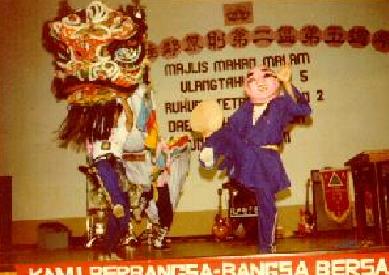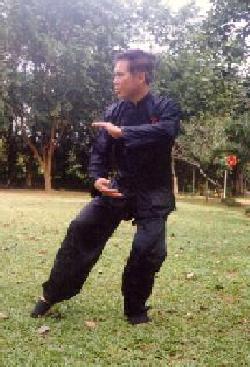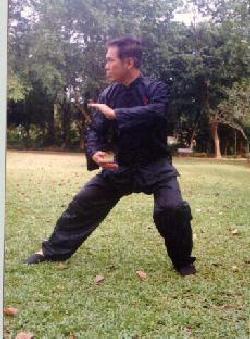February 2000 (Part 1)
SELECTION OF QUESTIONS AND ANSWERS

A lion dance performance taught by Sifu Wong. The lion dance is a popular feature during the Chinese New Year celebrations on 5th and 6th February, the year of the dragon.
Question 1
I realize that I can learn true taijiquan only through the guidance of a qualified master. I do intend to settle down after graduation and find a master to train with on a more long term basis, but right now I feel without root. I've received instruction from two teachers before and have read several books on taijiquan including your Complete Tai Chi Chuan. As I have no instructor at the moment, I am wondering if you have recommendations as to which exercises are safe to practice on my own until I find a teacher.
— Hu, Malaysia
Answer
What exercises when practised on your own will give you the most benefit, depends on various factors, such as your aims and needs as well as your background experience and the amount of effort you are prepared to put in. Presuming that you have no health problems, that you have some philosophical understanding of what Taijiquan is, and that you are prepared to put in about half an hour a day for your practice, I suggest the following two programmes to meet two diverse aims.
The first programme is suitable for most people, who wish to enjoy Taijiquan for good health and mental freshness, and later if the opportunity arises, to learn some self defence. First stand upright and relaxed at the Wuji Stance for about five minutes. Close the eyes gently and do not think of anything. Then perform any Taijiquan set. Breathe naturally and do not think of anything. After the set, stand at the Wuji Stance again for another five minutes.
After sufficient practice and if you relax enough, your body may sway while at the Wuji Stance. Enjoy the sway, but if the movements start to become vigorous, just tell your movements to slow down. After standing quite still for a minute or two, complete the whole exercise.
The second programme is for those who are more serious about Taijiquan training and are prepared to work hard. Stand at the Wuji Stance for about five minutes. Proceed to the Three-Circle Stance, starting with five minutes gradually working to fifteen minutes or more. Let your breathing be natural. It is very important that your stance is upright and relaxed.
Then perform only “Grasping Sparrow's Tail” for five minutes on one side, then another five minutes on the other side. If you know the breathing co-ordination, use it; if not, breathe gently and naturally. Complete the exercise with the Wuji Stance. Enjoy the sway if it happens. Not only this programme will give you good physical and mental health, it will provide you with an excellent foundation when you later learn from a real Taijiquan master.
Whether an exercise is safe depends not on what it is but on how you perform it. Generally if you keep to the following golden rule, you will be quite safe — be gentle and natural. If you tense your muscles or force your mind or emotion, even standing upright for five minutes can be harmful.
You have to pay particular attention to this golden rule of being gentle and natural when you perform the seemingly simple Three-Circle Stance. Nevertheless, performing “Grasping Sparrow's Tail” in a gentle and relaxed manner, and letting your body sway naturally during the concluding Wuji Stance can help to overcome any adverse effects unwittingly sustained.
Question 2
I've so far been practicing wuji meditation and the Grasping the bird's tail pattern as my regimen. Can I consider practicing “reverse” or “Taoist” breathing during my wuji meditation? Should I only concentrate on the forms?
Answer
The meditative Wuji Stance and “Grasping Sparrow's Tail” are wonderful exercises. If you practise them everyday (missing a session once a while is permissable), you would feel noticeable results in six months. If you practise them of and on, even if for years, you would only waste your time.
Do not worry about your breathing during Wuji meditation. Just breathe gently and naturally. Leave “reversed breathing” aside; it may cause you complications. Remember the golden rule of being gentle and natural. In this case, “reversed breathing” is not natural.
While “reserved breathing” is excellent for combat purposes and for certain types of chi kung like Golden Bell, it is generally not suitable for meditation. While it looks simple, it requires much skill to practise it, and it is not the same as ordinary chest breathing although it may appear so.
“Reversed breathing” is not necessarily Taoist breathing. It is also found in other schools of chi kung, including many styles of Buddhist chi kung. On the other hand, there are many other types of breathing, such as natural breathing and abdominal breathing, in Taoist chi kung.

Sifu Wong demonstrating “Grasping Sparrow's Tail”
Question 3
I recognize the necessity of finding a master, but on the other hand I have learned exercises from other instructors; how should I decide which ones to practice? Any advice is greatly appreciated.
Answer
Very few people have the good luck to meet real masters. If the instructors are competent and what they teach is genuine, you can reach very high levels too.
A useful way to help yourself to make a good decision is first examine your aims and objectives, then choose the exercises that best help you to meet your aims and objectives, considering also the time and effort demanded by the exercises.Question 4
When one is practising Chi Kung regularly, would one still benefit from the regular use of Chinese Tonic Herbs such as ginseng, ho shou wu and others. If there is benefit, do you use any, and if you do, what are your favourite herbs?
— Alan, UK
Answer
Regarding herbs, different masters may have different views. To me, if one practises chi kung, especially high level chi kung, it is not necessary to take any herbs, vitamins or food supplement.
There is a Chinese saying as follows: "Taking herbal supplement (including vitamins, etc) is inferior to taking good food; taking good food is inferior to taking energy (i.e. practising chi kung)."
After digestion, absorption and other metabolic processes, herbal supplement and good food will also produce energy; but taking energy from the cosmos through chi kung training is the most direct, economical and effective. I always practise what I teach. Hence I do not take any herbal supplement or vitamins.
Nevertheless, while it is not necessary and personally I do not favour it, one can still benefit if he takes Chinese tonic herbs like ginseng and “ho shou wu” regularly but moderately, such as once a month. Taking ginseng is like a quick but expensive way of doing chi kung. “Ho shou wu” helps a person to keep his hair black.
My favourite, the one I would recommend to someone too lazy to practise chi kung, is “pat chan” (or "ba zhen” in Mandarin pronunciation). “Pat chan”, which literally means “eight treasures”, is not one herb, but a classic combination of eight herbs.
This herbal combination was regularly taken by empresses, princesses and court ladies in the past. While it is particularly beneficial to women — many modern Chinese women take this herbal combination to replenish themselves after their monthly period — it is also beneficial to men. Its main function is “to nourish blood and circulate chi”.
The ingredients of “pat chan” are as follows: yien sam (ginseng), pak shirt, fok ling, kam choe, tong kwai, tei wong, pak cheok, chun kung. (The pronunciation is in Cantonese).

Sifu Wong demonstrating “Grasping Sparrow's Tail”
Question 5
I have written many time but have never got an answer, this time I will try to do everything perfectly. My name is Tristan, I live in Australia, I have been to your websites such as www.geocities.com/~wahnam.
I will be going along to a wushu class. I have asked to train more towards self defence, and my question is: Is Baguazhang an effective form of self defence?
— Tristan, Asutralia
Answer
I receive literally hundreds of e-mails, and as time is limited it is logical to give preference to those who fulfill the simple requirements of stating their name, country and website reference. Those who do not even bother to address the recipient or put their own name or pen-name, will have their e-mails removed automatically.
It is only simple courtesy. If we wish to ask someone for a favour, like asking expert advice for free, the least we would do is to be polite. Manners seem to have changed drastically. Some of the e-mail senders (but not you) seemed to think that they were doing me a favour by asking me questions. One person actually said that.
Baguazhang is a very effective form of self defence; it is also very effective for attack. It is one of the three famous styles of internal kungfu, and is famous for its footwork. A Baguazhang master can get behind an opponent without the opponent being aware of it! A Baguazhang master also has much internal force; one strike of his palm may be enough to kill or seriously injure an opponent. Interestingly, the fist and the fingers are not used; only the palm is used in Baguazhang.
Actually any style of kungfu — such as Baguazhang, Taijiquan, Praying Mantis, Lohan or Chaquan — is effective for combat. But any style of kungfu is not effective if it is practised as gymnastics or dance. In other words, if for any reasons your teacher teaches you — or you practise — only the external forms of Baguazhang, and he never teaches you — or you never practise — how to develop internal force and how to apply what you have learnt for combat, you will not be able to use your Baguazhang (or any kungfu for that matter) for self defence even if you learn for your whole life time.
You mentioned that you attended a wushu class. The term “wushu” as used today has two different meanings, although many people have not paid much attention to the difference. One, “wushu” especially in the Chinese language, means “martial art”. Two, “wushu” as practised by many people today is a demonstrative form for sport (and not for combat). So you have to make sure which meaning your “wushu” takes.
If your “wushu” is a martial art, then your Baguazhang wushu is effective for self defence, provided of course your teacher has taught it to you as a martial art, and you have practised it properly. If your “wushu” is a demonstrative sport, then your Baguazhang wushu will never be effective for self defence, irrespective of how your teacher teaches and how you practise. But if it is taught and practised well, it will be magnificent to watch.
Question 6
I have been practicing staying in the horse riding stance for longer periods as you recommend in your book. I read on your website about using the “Golden Bridge” technique with both arms extended with hands in One-Finger Zen position. Is this the best hand position to use while practicing the horse stance, versus both hands in fists at the waist as typically illustrated?
— Bill, USA
Answer
You should first practise the Horse-Riding Stance with your fists at your waist. This is the best position and it focuses your chi at the abdominal dan tian.
Later, when you can perform the Horse-riding Stance well, you can proceed to Golden Bridge where you hold your arms straight ahead with the fingers at the One-Finger Zen form. The Golden Bridge develops internal force.
Sifu Wong demonstrating “Grasping Sparrow's Tail”
Question 7
My previous Kung Fu experience is in Lau Gar Kung Fu, which I have practised for 3 years now. I have given it a great deal of thought, and I am seriously considering choosing Kung Fu as a “career” choice. I would greatly appreciate your insight into what a life as a Kung Fu master is like.
— David, USA
Answer
Three years will give you a good foundation. At 15 it is too early to choose a career. You may think about it, but you may (or may not) change your choice later. Meanwhile, I would suggest that you focus on your school studies, and take kungfu as a hobby, albeit with an awareness that this hobby may one day be your career.
Many people consider the time between 15 and 25 as the golden age of youth. You should wholesomely enjoy your youth now, rather than seriously working on your career. I do not suggest that you would spend all your time on dates and parties, and never even think of your work or career. What I mean is a happy balance, and practising genuine kungfu (which includes chi kung and meditation) will enable you to appreciate better the happy balance between work and play.
Personally I consider your making kungfu a career to be a good choice, but it is utmostly important that it is real kungfu, and not just kungfu gymnastic or dance. Your kungfu training should have the following three dimensions — combat efficiency, internal force training and spiritual cultivation.
But don't rush into your choice; give yourself sufficient opportunities to try other possibilities. Should you finally decide on kungfu as a career, and if you qualify, you may like to join the core of instructors I hope to train to be real Shaolin masters to preserve and spread genuine Shaolin Kungfu.
Question 8
Lau Gar is not necessarily the style that I would want to master (I prefer conventional Shaolin footwork to the glide-step we mainly use in Lau Gar). At our club, we do not learn Kung Fu gymnastics, and we do use Kung Fu techniques for fighting, but our class has the distinct lack of the internal realm.
Answer
In my opinion Shaolin Kungfu offers much more scope and depth than Lau Gar Kungfu (which is a style of Southern Shaolin). I am glad that you use kungfu techniques for combat.
Combat efficiency is the most basic requirement of kungfu — if an art cannot be used for combat, it cannot be called kungfu. The next level is internal force training. It is the internal dimension that distinguishes good kungfu from ordinary kungfu, and from martial arts of other systems.
The highest level is spiritual cultivation. It is this spiritual dimension that distinguishes great kungfu from good kungfu. Obviously, if you wish to make kungfu your career, you must choose the greatest kungfu, or if you do not have this opportunity at least choose great kungfu.
To me the greatest kungfu is Shaolin Kungfu, and the reasons are explained in my webpage Why Shaolin Kungfu is the Greatest Martial Art. I say that Shaolin Kungfu is the best not because I practise it; it is the other way round — because it is the best that I practise it. Had another style been better, I would have chosen that other style.
Question 9
My sifu does practice Chi Kung but doesn't claim to teach it, and I realise that it is something that I will need to practise in order to advance in Kung Fu. It is for this reason, mainly, that I would greatly like to attend your courses.
Answer
You are right. Years ago my sifu, Sifu Ho Fatt Nam, told me that if I wanted to soar the greatest heights and reach the greatest depths of kungfu, I must practise chi kung; and to soar the greatest heights and reach the greatest depths of chi kung, I must practise meditation.
In other words, to have combat efficiency you need energy management, to manage energy well you need a trained mind. Hence, much of my kungfu course concerns energy and mind training.